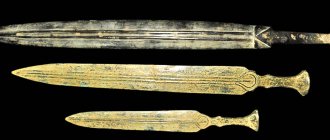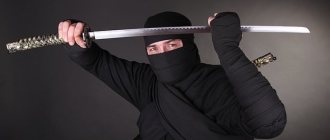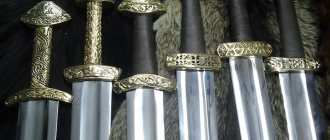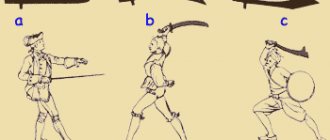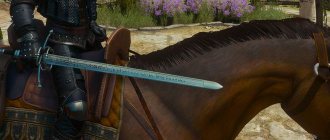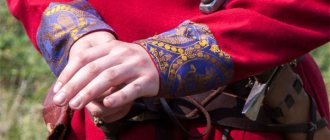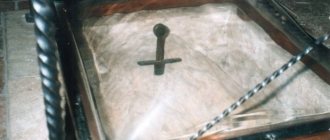The sword (English - small sword - small sword, or French - épée de cour) is a long-bladed piercing (piercing-cutting) edged weapon that came into use in the second half of the 17th century. The sword had a blade that was shorter and lighter than that of a rapier, usually of a triangular cross-section with concave edges; exceptions could be early types of swords that had flat rapier blades, or standard swords designed for the military.
Noble swords of the 18th century
Combat saber
Having considered the differences between a rapier and a sword, attention should be paid to weapons such as a saber.
This is one of the most ancient weapons. Due to its characteristics, modern techniques of sports combat have also been formed.
The saber is a cutting weapon. Its blade has a curved shape. With the help of a saber it is also possible to deliver a piercing blow. For this purpose, the tip was well sharpened by the warriors before the upcoming battle.
The presented type of weapon appeared in the eastern territories. Such products became widespread back in the 7th-8th centuries. With its help, chopping and piercing wounds were inflicted. Over time, the design has changed. By the 14th century, it was already an exclusively chopping blade, characterized by significant curvature. The weight was relatively light. The center of gravity was shifted away from the hilt. This made it possible to strike with greater force.
Pommel (“apple”)
Handle head. Toledo, Master Juan de Azcoitilla, first half of the 16th century. The structure of the saber: A
- hilt (handle,
cover
).
Parts
B ,
C
,
D
,
E
do not belong to the hilt
[12]. 1
— pommel (
back plate
,
handle head
).
2
— black (
handle
).
3
- crosshair.
4
— crosspiece (
guard
,
flint
,
grate
).
Details
5 -
10
do not relate to the hilt
[13].
The pommel (or head of the handle) of the “apple” type performs three functions:
- serves as a counterweight, improving the balance of the weapon (which is why it is often made of heavy material (for example, lead));
- keeps the hand from slipping (for example, when delivering slashing blows, the weapon can “break out” under the influence of the centrifugal force that arises, especially if the fighter is weakened from fatigue or wounded);
- serves for attaching a handle made of any material to the blade shank.
Precious stones were sometimes inserted into the “apples”.
Historically, there were two main forms of pommels: Slavic-Germanic (semi-oval) and Roman (round).
A closed or semi-open hilt with additional arms and other elements is complex (or developed). Performing the “half sword” technique (Mordhau). Drawing from the Wallerstein Codex (English) (Russian) According to the treatises of that time, fighters sometimes took their own sword with both hands by the blade, striking with the pommel and cross.
Notes
- ↑ European Weapons and Armour. From the Renaissance to the Industrial Revolution” by Ewart Oakeshott, FSA ISBN 0-85115-789-0, section “The Reitschwert or 'Sword' and the Rapier”, pages 134-139 in the 2000 edition from Boydell Press, Woobrige
- ↑ "European Weapons and Armour. From the Renaissance to the Industrial Revolution" by Ewart Oakeshott, FSA ISBN 0-85115-789-0, Chapter XIV "The SmallSword", pages 236-253 in the 2000 edition from Boydell Press, Woobrige
- ↑ "European Weapons and Armour. From the Renaissance to the Industrial Revolution" by Ewart Oakeshott, FSA ISBN 0-85115-789-0, Chapter XIV "The SmallSword", section "Blades" pages 251-252 in the 2000 edition from Boydell Press, Woobrige
- "European Weapons and Armour. From the Renaissance to the Industrial Revolution" by Ewart Oakeshott, FSA ISBN 0-85115-789-0, Chapter XIV "The SmallSword", section "Blades" pages 251-252 in the 2000 edition from Boydell Press, Woobrige
- Wendelin Boeheim “Handbuch der Waffenkunde. Das Waffenwesen in seiner historischen Entwicklung vom Beginn des Mittelalters bis zum Ende des 18 Jahrhunders" Leipzig 1890, chapters "Degen" and "Dolch"
- Wendelin Boeheim “Handbuch der Waffenkunde. Das Waffenwesen in seiner historischen Entwicklung vom Beginn des Mittelalters bis zum Ende des 18 Jahrhunders" Leipzig 1890, chapter "Dolch"
- European Weapons and Armour. From the Renaissance to the Industrial Revolution” Ewart Oakeshott, FSA ISBN 0-85115-789-0
- ↑ "European Weapons and Armour. From the Renaissance to the Industrial Revolution" by Ewart Oakeshott, FSA ISBN 0-85115-789-0, Chapter VI "Swords of the Sixteenth Century", section "The Reitschwert or 'Sword' and the Rapier", pages 134-139 in the edition 2000 from Boydell Press, Woobrige
- "European Weapons and Armour. From the Renaissance to the Industrial Revolution" by Ewart Oakeshott, FSA ISBN 0-85115-789-0, chapters VI "Swords of the Sixteenth Century", IX "Sword and Rapier in the Seventeenth Century" and X "The Military Sword of the Seventeenth" Century"
- "European Weapons and Armour. From the Renaissance to the Industrial Revolution" by Ewart Oakeshott, FSA ISBN 0-85115-789-0, chapters VI "Swords of the Sixteenth Century", IX "Sword and Rapier in the Seventeenth Century" and XIV "The SmallSword"
- "European Weapons and Armour. From the Renaissance to the Industrial Revolution" by Ewart Oakeshott, FSA ISBN 0-85115-789-0, chapter VI "Swords of the Sixteenth Century", section "Four Families of Swords", pages 126-127, in the 2000 edition from Boydell Press, Woobrige
- "European Weapons and Armour. From the Renaissance to the Industrial Revolution" Ewart Oakeshott, FSA ISBN 0-85115-789-0
- Bakal D.S. et al.
Great Olympic Encyclopedia. - M.: Eksmo, 2008. - P. 586.
Epee for sports fencing
The differences in the sport of foil and epee are quite noticeable. They determine the style and technique of the fight. Today it is mainly a weapon used during sports tournaments.
The sword, which is used in competitions at the highest level, has a length of 1.1 m. The mass of such a product is invariably 0.77 kg. The blade blade is flexible. It bends strongly when stabbing. The cross section of the blade is triangular.
The round shape protects the hand from impact. Its diameter is 13.5 cm. The sports equipment has a blade that gradually tapers towards the top. The size of the edges allowed by modern fencing is 2.4 cm.
Receiving an item
Methods of obtaining
This item can be obtained in the following ways:
| Qty | Ingredient | General Notes | Type |
| 9 | Jester
| random RuthlessRuthlessPrefix(170-179)% increased physical damage for level 100 one-handed weapons | Automatically |
| 9 | Tyrant
| random RuthlessRuthlessPrefix(170-179)% increased physical damage for level 100 weapons | Automatically |
| 8 | Web
| random weapon craftcraftsuffixcan have up to 3 craft properties | Automatically |
Sports foil
Sports foils differ from swords in their parameters. So, the cross-section of the rapier is tetrahedral. The length of the blade is 90-110 cm, and the weight of the weapon does not exceed 500 g. The hand is protected by a metal guard with a diameter of 12 cm.
The blade proportionally decreases in cross-section towards the apex, which is equipped with a tip with a diameter of 6 mm.
For weapons used in competitions, the tip is a movable electrical contact device. It reacts to a thrust inflicted on the enemy. When the circuit is closed, the signal is sent through a wire that runs along the recess of the edge from the tip to the guard. Under the guard there is a connector to which a wire is glued.
In addition to the basic parameters, there is one more difference between a rapier and a sword. Sport allows you to use different tactics and combat techniques. It is the rapier that sometimes allows you to replace a straight handle with a figured one. This shape is called a “pistol” shape and allows you to avoid bending your wrist while gripping the handle.
Haudegen
The Haudegen (English Mortuary sword, German Haudegen) is a heavy cavalry sword used since the 1620s by cavalry throughout Europe, especially in England. The blade often had a one-sided sharpening and a length of at least 900 mm. The guard does not have a cross, but the basket is clearly defined. The handle is often very intricately decorated. Haudegen weighed between 1100-1200 grams.
12. Pokoinitsky sword (broadsword), England, 17th century. He's gorgeous!!
13.
14.
15. Next are some beautiful handles of other bladed weapons. Court "bump" sword in the diamond cut style
16. Rapier with a closed hilt inlaid with silver. The blade was made in Solingen around 1610. The handle in Milan - around 1610-1615.
17.
The next two beauty ambassadors amazed me. Very beautiful and delicate work.
18.Chopard created a unique sword for the French-Russian prose writer Andrei Makin, who was elected to the French Academy in March 2016 for his contribution to the development of the French language. The unique sword was created in close collaboration with the academician and embodied the motifs of winter - Makin’s favorite time of year. 11 Chopard craftsmen worked to create this work of art. The silver handle of the sword is made in the form of an intertwined rope, and the handle is completed by a small figurine of the fairy-tale Frog Princess, decorated with 500 tiny emeralds. The inside of the handle is made in the shape of an hourglass made of quartz and complemented by yellow gold balls, the movement of which is meant to remind of the passage of time. The unification of Russian and French cultures is indicated by the letter F engraved on the guard in Cyrillic and Latin script. The guard is made in the form of parchment pierced with a feather.
19. Sword of honor, awarded to Monsieur L. de Tanlay, Prefect of the Somme, by the Association of Antiquaries of Picardy, April 1854. Dimensions: overall length 887 mm, blade length 748 mm, blade width 18.5 mm, scabbard length 785 mm, diameter of large medal 50.5 mm, diameter of small medals 33.5 mm. Material, technique: steel, silver, wood, leather, velvet; forging, casting, carving, etching, stamping. The blade is made of Damascus steel, straight, double-edged, with a rhombic cross-section. The silver hilt of artistic work consists of a handle and a guard.
Combat rapier
Having considered the question of how a sword differs from a rapier and a saber, a few words should be said about other types of historical weapons. Their main characteristics were finally determined at the end of the 15th century. The historical foil differs significantly from modern fencing equipment.
Translated, rapier literally means “sword for clothing.” This is a lightweight, practical weapon. In ancient times, it was worn not by the military, but by wealthy citizens of Spain. It does not cut as hard as a sword. However, her blades are sharpened.
It was a very popular weapon in the 15th-16th centuries. Later, rapiers were replaced by short swords. The latter were lightweight, but were more effective in battle.
The product, which was historically called a rapier, had a length of about 1.3 m. Its blade reached a length of about 1 m. There were many varieties of weapons presented. Historical fighting blades weighed more than modern sports equipment.
Hilt and handle
An ancient sword with a decorated guard.
The hilt is the part of the hilt by which the sword is held. The hilt ends with a pommel or headband. It is also called an apple due to its similar shape. The guard and pommel can be used to deliver crushing and stunning blows in close combat. On expensive swords, often ceremonial rather than combat, the hilts were decorated with patterns and precious stones.
The handle should be comfortable to grip; this determines how well you can fencing with a sword.
Therefore, you need to buy a sword in a place where you can try it out. Pick it up, understand balancing, try a few fencing and slashing techniques.
Sports sword
A sports sword is a weapon used in fencing and consists of a flexible steel blade, a protective guard and a handle. The main characteristic of a sports sword is a blade with a triangular cross-section (maximum edge width 24 mm), thinning towards the top, on which there is a tip with a movable electric contact mechanism.
The standard length of a sports sword is 110 cm, weight 770 grams.
The rules of fencing competitions establish the following: the length of the blade to the guard should not exceed 90 cm, and the deflection of the blade should not be more than 10 mm, the diameter of the guard should be 135 mm, and the mounting hole should be located at a distance of no more than 35 mm from the center point of the guard. The size of the handle of a sports sword with a nut should be no more than 235 mm.
In the 19th century, fencing emerged as a sport.
Epee fencing competitions are held for both men and women.
In 1860, the first official Russian fencing championship took place.
From August 15 to 21, 1928, as part of the First All-Union Spartakiad, the first USSR Championship was held, in which 110 athletes from 13 republics, cities and regions took part. The list of national champions was opened by foil fencers Konstantin Feldman and Ekaterina Lopatina, saber fencer Yuri Mordovin, Nikolai Afanasyev, as well as A. Nechaev, who won the rifle fencing tournament with an elastic bayonet.
The women's epee debuted at the Olympic Games in 1996 in Atlanta (USA). The first champion was the Frenchwoman Laura Flessel.
Handle (“black”, “stem”)
A “cheren” type handle [10] serves to hold the weapon, is attached to a tongue [14], is usually made of wood or metal, and is often covered with leather or other rough material to avoid slipping (to increase friction). From the second half of the 19th century, rubber was also used to increase friction. Sometimes the handle was additionally wrapped with rope.
The handle could be for one hand or for two [15]. Sometimes a ring was attached to the handle to hold the weapon in a horizontal plane.
Fencing with sword
The main feature of the sword is the presence of a complex guard that protects the hand well; it is this guard that allows you to use protection based on short, laconic movements without risk to your fingers. For comparison, when fencing with the Chinese jian sword, which has a blade similar to the blade of a combat sword, due to the minimal guard for protection, long sweeping movements are often used, which in European fencing are characteristic of bastard swords, and not of epee. The clear predominance of piercing blows over all others is explained by the fact that civilian swords were too light for slashing blows, and combat swords were initially used against opponents in armor, who were easiest to hit with a thrust into a vulnerable spot.
Spanish school
Main article: Destreza
Unlike other regional schools of sword fencing (which actually survived only in the form of theatrical fencing), it relatively successfully survived the rivalry with the French school of fencing, moving into the Philippine Martial Arts - in Arnis, Eskrima and Kali, where Spanish is still widely taught and used Spanish name espada y daga
(espada and daga), with the difference that in the Filipino version, instead of a sword and daga, a machete and a knife are used.
Italian school
Main article: Italian fencing school
See also: Bologna School of Fencing and Venice School of Fencing
It was the Italians who first created the principle of “killing with the point, not the blade.” A dagger or daga was often used as a second weapon. But they could use both a fist shield and a cloak, and experienced fencers could fence with two swords at the same time.
German school
Main article: German fencing school
A characteristic feature is the relative abundance of chopping and cutting blows. As an auxiliary weapon, the reiters often used a heavy cavalry pistol (a little less than a meter long) with a heavy bound counterweight pommel, which, held by the barrel, was used to strike like a club. In addition, swords were popular in Bavaria, which were also bastard swords, with which you could deliver a heavy slash with both hands, grabbing the sword by the “apple.”
English School
Main article: English school of fencing
As auxiliary weapons, both a small shield-brass knuckles (called a buckler) and a dagger/dagger (in English this is the same word as dagger) were popular. At the beginning, the development of the school was based on the use of a light sword and buckler shield, which were later replaced by the use of a broadsword. Later, elements from European schools of fencing began to appear in the islands of Britain. The first works on English fencing are considered to be the treatises of Sir William Hope. In his works one could find both techniques inherent in the French school and purely English fencing movements. The English school used both thrusts and blows, and sometimes prescribed various weapons of the second hand: from a buckler shield to a pistol taken by the barrel.
French school
Main article: French school of fencing
It was this school that gave birth to the shortened faceted blade and, gradually displacing all other fencing schools, served as the basis for modern sports fencing. Initially, the French sword had blades and a large length, but lightening the sword, first by shortening and then losing the blades, made it possible to fencing faster than an opponent with a long but heavy blade. At the same time, in the era of the Sun King, along with light triangular swords, one and a half kilogram heavy blades a meter long still continued to exist and be used.
Shape and device of the sword
There is an opinion that the blade of a sword can be straight or curved. To understand the issue, the wording from official sources is considered. GOST R 51215-98 shows that only contact weapons, piercing and chopping, with a blade that can be considered a sword:
- straight;
Katana is a samurai sword. - massive;
- long or medium;
- has two blades.
From the definition it is clear that if the blade deviates from the straight shape and is sharpened on both sides, the weapon can no longer be considered a sword.
This is not a one-sided opinion of the Russian standard. The Japanese also distinguish between a sword and a katana; it is classified as a two-handed saber. There are two main parts of this weapon:
- blade;
- hilt.
The blade of a sword is its combat piercing and cutting part, measuring from 60 cm. Considering this part, we distinguish:
- Blade , used for both cutting and chopping actions. It was not sharpened to a razor sharpness; such a blade would break if it hit the armor or shield. But the sharpness was enough to cut the enemy or cut off his limbs. Double-sided sharpening makes it possible to cause damage when moving backwards.
- The fuller is made to improve the rigidity of the blade structure. It becomes stronger for side loads and the weight of the weapon is reduced.
- The point is used for stabbing. They can hit the joints of armor if the enemy is wearing armor.
- Ricasso is the part of the blade adjacent to the handle and not sharpened. This part makes it possible to make the handle shorter. This handle provides good control of the blade when stabbing.
As can be seen from the description, the hilt is also an important element, and if it is made correctly, the sword becomes obedient.
The hilt on the sword also has components, each with its own functions:
- Handle. Sword guard.
- pommel
- Garda.
We will analyze each part of the hilt separately and in more detail.
Saber in fencing
It is easy to determine the differences between a rapier, an epee, and a saber in sports, knowing the characteristics of each type of weapon. All presented equipment appeared on the basis of its historical ancestors. Thus, a saber is a cutting weapon, capable of also piercing blows. In cross section, such a product has a trapezoidal shape. The length of the blade reaches 1.05 cm.
The castle has a special design. It is able to protect the hand from below and from above. During the fight, you can strike only in the upper body. This also applies to the hands (up to the wrists), as well as the area of the protective mask.
A special device records the injection and blow. The clothing, which is located in the upper part of the swordsman's torso, contains special silver shavings. Saber fencing is conducted with the right to advantage in attacks. The fight is dynamic and spectacular. This is why many fencers like him.
Types of European swords
The length of the handle determines whether the sword can be held with one hand or two. Based on the number of grips, this weapon is divided into the following types:
- One-handed is a light weapon, its weight ranges from 700 grams to 1.5 kg. As a rule, this is a short sword.
- The one-and-a-half-handed one is heavier than the previous one and longer. The length of the handle is not enough to freely grab the weapon with both hands. The blade is long.
- The two-handed one has a lot of weight, it ranges from 3.5 to 6 kg, and the length reaches up to 140 cm.
Another classification is also familiar. It is based on the length of the blade:
- the short one has a blade from 60 to 70 cm and is used for close combat;
- the long one has a blade of 90 cm;
- cavalry is made with a blade more than 90 cm, as it is used by a horseman, including against a foot enemy.
Both classifications are related. It is logical that a long sword will weigh more and will have to be held with both hands.
History of changes[edit | edit code]
| Version | Changes |
| 2.6.0 |
|
| 2.2.0 |
|

